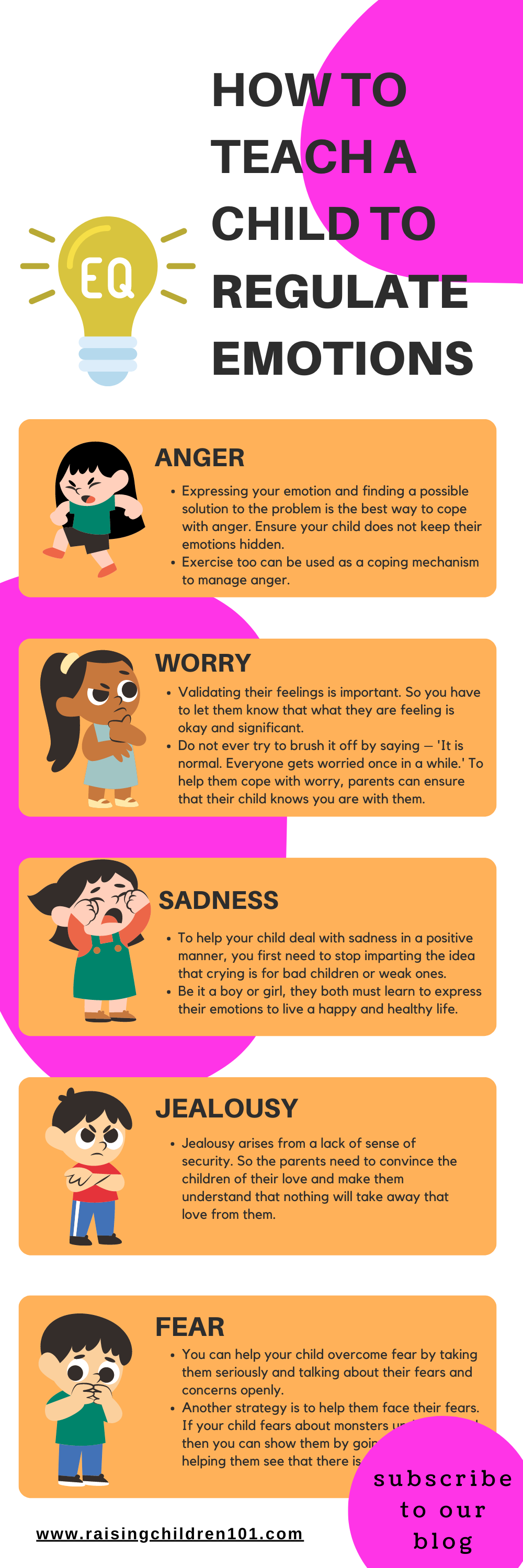Kanika reminisces the day her daughter who was 6 at the time of the incident could not comprehend happy tears. Her father had cried with joy over something their daughter had said. Their daughter was perplexed to see tears in her father’s eyes. For her, tears meant sadness until Kanika tried really hard to make her understand how emotions are complex and that not every person manifests an emotion in the same way. The most difficult part was making her understand how our brain often gets confused when we feel an emotion with great intensity.
Emotions are a complex reaction pattern involving experiential, behavioral and physiological elements as defined by American Psychological Association. Regulating emotions is an essential life skills to teach your child.
Williams James and Lange in their theory assert that emotions follow a body change. So, if you smile, you automatically start feeling happy. However, our brain works on basic instincts, and emotions often confuse us. So, it becomes important to identify the correct emotions by asking children a few – what, why and how? The very first step to teach a child to regulate emotions is by helping them learn about their emotions.
Graziano (2007) found that emotion regulation was positively associated with good academic performance. Thus, it is significant to teach children about emotions.
5 emotions to talk about to teach a child to regulate emotions
Here are five important emotions to talk about with your child to teach them how to regulate emotions.
1. Anger
American Psychological Association (APA) defines anger as ‘an emotion characterized by antagonism toward someone or something you feel deliberately done you wrong.’ While the definitions of anger vary, a general consensus settles on ‘feeling of antagonism developed out of hurt.’
How to identify the emotion?
If someone hurts your child, they are likely to feel anger as a form of defense. Psychologists believe that anger can be a good thing as it helps your child deal with negative feelings, but too much of anger can be destructive.
Anger can be identified in many ways, from clenched jaws to furrowed eyebrows to increased heart rate.
How to explain the emotion?
It is important that both you and your child are able to identify anger so that dealing with the emotion in a positive manner can become possible.
You can ask your child questions like ‘How do you feel?’ or if you see them clenching their fist, then you can simply ask them, ‘Do you feel angry?’
Sometimes children do not understand the emotion they are feeling. So it is important that they learn to identify their emotions. Learning the symptoms and pondering over their emotions can help.
Coping strategies to make things easier
Once they learn to explain how they feel and answer your questions, you both can quickly name the emotion and find a constructive method in response. Coping with anger is important as children need to learn that anger can be destructive.
- Expressing your emotion and finding a possible solution to the problem is the best way to cope with anger. Ensure your child does not keep their emotions hidden.
- Exercise too can be used as a coping mechanism to manage anger, as concluded by Priyanka Malhotra in her research titled ‘Exercise and its Impact on Anger Management.’
- Research also claims that mindfulness meditation, keeping a journal to express emotions, and even enrolling in aggressive sports that let the children burn their anger can prove to be quite effective.
- Breathing, counting to ten, venting in private can be a few coping strategies that your child can implement to manage their anger.
Recommended reading: Anger Management For Kids
Recommended reading: 10 Activities To Teach Impulse Control To a Child
2. Worry
Worry is a state of mental distress or agitation due to concern about an impending or anticipated event, threat, or danger, as defined by American Psychological Association.
In general terms, worry often precedes an event that we are apprehensive about. Children worry about exams as they may consciously think – What if something comes out of syllabus? Thus, uncertainty gives rise to worry.
The underlying stress causes a person to worry.
How to identify the emotion?
Worry can be identified by restlessness, anxiety (in extreme situations), shivering, recurring nightmares, or dreaming about a particular event.
Borkovec and Ruscio (2001) stated that worry is characterized by repeated experiences of thoughts about potential negative events. Children may show signs like frowning, shaking legs, restlessness in their actions, etc. if something is worrying them. Crying, disturbed sleeping pattern, eating less are also a major sign of worry among children.
How to explain the emotion?
To explain what ‘worry’ is when you teach a child to regulate emotions, you can model your example that how sometimes you feel anxious, and apprehensive – which is you being worried – before an event.
You can give them an example of a hypothetical situation and real one. Then explain how the difference causes a person to worry. For instance, ‘Before my presentation at my workplace, I felt shivers and tense because I was worrying what if it does not go the way I plan it to go. What if I falter? What if my pen drive does not work? Have you ever felt this way before an event?’
This would not only help your child understand about this particular emotion but will give them an opening to talk about their own feelings. This in turn, will help teach a child to regulate emotions.
Coping strategies to make things easier
If your child worries, to help them cope with it, you can work on their confidence building and assurance in their self.
- Validating their feelings is important. So you have to let them know that what they are feeling is okay and significant.
- Do not ever try to brush it off by saying – ‘It is normal. Everyone gets worried once in a while.’ To help them cope with worry, parents can ensure that their child knows you are with them.
- Gently tell your child a few things like – ‘I am here for you’ or ‘If something is bothering you, you can tell me. I will help you without any scolding or judgment.’
Recommended reading: Why Kids Should Learn Labeling Their Emotions?
Recommended reading: 3 Ways To Help Child Express Emotions
3. Sadness
Legendary writers, poets and philosophers like Aristotle have argued that intellectual people often carry an air of melancholy with them. But to see your young one looking dejected as if the world has hurt them beyond repair can be heartbreaking to any parent.
American Psychology Association (APA) defines sadness as “an emotional state of unhappiness, ranging in intensity from mild to extreme and usually aroused by the loss of something that is highly valued.”
How to identify the emotion?
Sadness is considered to be one of the most basic emotions and often characterized by feelings of loss, despair, and disadvantage.
Sadness takes away the brightness from your child’s eyes. Their shoulders appear slumped, they do not talk much, they appear disinterested and often cry. No interest in playing with others or laughing less indicates sadness in children.
Dr. Paul Ekman famous for his research studies on facial expressions identifies sadness with inner corner of eyebrows pulled up together; upper eyelids dropped and eyes looking down, and lips corner pulled downwards.
How to explain the emotion?
When you teach a child to regulate emotions, teaching about sadness to the child by explaining the feelings, facial expressions and body language can be quite helpful.
To help your child explain sadness, you can also use examples from movies and books. How the loss of something or some event makes the characters sad and how they show their sadness in their entirety can help your child understand sadness.
Dr. Paul Ekman also suggests that people feel sad even when they are happy. So, storylines and backgrounds give children a detailed framework of how emotions like sadness work.
Coping strategies to make things easier
Coping with sadness can vary as some people turn destructive while some turn constructive.
- To help your child deal with sadness in a positive manner, you first need to stop imparting the idea that crying is for bad children or weak ones.
- Be it a boy or girl, they both must learn to express their emotions to live a happy and healthy life. Suppression of emotions gives rise to crimes and criminals.
- Crying over a loss, writing about their emotions, talking to their parents about their sadness are a few constructive ways to let go of sadness or grief.
- Making them understand that gain and loss are a part of life and that sometimes, you have to let go can prove immensely fruitful to kids in coping with sadness when they grow up and face eventual disappointment and loss in their life.
Recommended reading: How To Explain Death To A Child
4. Jealousy
Jealousy is often explained as fear and insecurity over losing affection or lack of security. American Psychological Association (APA) defines jealousy as “a negative emotion in which an individual resents a third party for appearing to take away (or being likely to take away) the affections of a loved one.
Jealousy requires a triangle of social relationships between three individuals: the one who is jealous, the partner with whom the jealous individual has or desires a relationship, and the rival who represents a pre-emptive threat to that relationship.”
How to identify the emotion?
Children often feel jealous over parents’ love and affection. They feel jealous if their caregivers do not give them all their attention. Toys and other things come secondary to that. While people say that jealousy is irrational, it is not all the time.
There are three types of jealousy – rational, family, and pathological. So from rational to irrational, jealously is complex. Feelings of insecurity, sadness, fear, possessiveness, throwing tantrums, crying, and even being violent to the other party in some cases are a common sign of jealously.
How to explain the emotion?
Conversing about jealousy, its effects and causes help make the children understand it. If you feel your child is being jealous, you should ask them about their feelings and what you can do to make it go away.
Coping strategies to make things easier
Jealousy, as any other emotion, is not always bad. A 2021 research study showed that jealousy helps in protecting and maintaining relationships.
- Jealousy arises from a lack of sense of security. So the parents need to convince the children of their love and make them understand that nothing will take away that love from them.
- Telling your kids ‘I am your mother and will always be’ helps them fight irrational jealousy.
Recommended reading: Don’t Compare Your Kids
Recommended reading: How To Help Children Stop Comparing Themselves To Others
5. Fear
Fear, according to American Psychological Association (APA), is defined as “a basic, intense emotion aroused by the detection of imminent threat, involving an immediate alarm reaction that mobilizes the organism by triggering a set of physiological changes. These include rapid heartbeat, redirection of blood flow away from the periphery toward the gut, tensing of the muscles, and a general mobilization of the organism to take action.” Generally, the response is to either fight or flight.
How to identify the emotion?
Children often face fear over a lot of things – from separation to mythical monsters to fear of the dark to fear of animals. Studies have found that around 43 percent children aged between 6 and 12 suffer from various fears and concerns.
Fear makes your kids unable to sleep, unable to expand their horizon and feel true happiness. Fear can be identified by feelings of threat, alarm, jumpiness, etc.
How to explain the emotion?
Asking your child specific questions and answers to their questions can help you make them understand fear better.
You can explain fear to them as shivers that leave goosebumps and make you feel cold or sometimes, sweat with trepidation. Watching videos, reading books and animated movies depicting fear provides a better chance to clearly explain fear to children.
Research shows that fears often give rise to anxiety, so coping with fear is important for children.
Coping strategies to make things easier
Understanding and validating your child’s feelings is important to help them overcome their fears.
- You can help your child overcome fear by taking them seriously and talking about their fears and concerns openly.
- Comforting your child by giving them a hug and telling them, ‘I am here. It is okay’ will give them a sense of comfort and security, helping them cope with their fears.
- Avoiding complete darkness in the room and not watching or talking about scary things that your child fears will also help.
- Another strategy is to help them face their fears. If your child fears about monsters under the bed, then you can show them by going under it and helping them see that there is nothing like that.
- As your child grows, their fears also grow from stupid to serious, so open communication plays a vital role in overcoming fears.
Infographic: Teach a child to regulate emotions

Conclusion: Teach a child to regulate emotions
Emotions vary from simple to complex and often, people feel many emotions at the same time. Emotions can be overwhelming, thus. For children, emotions can be confusing as they may not understand what and why they are feeling the way they feel and how to deal with their emotions. So, as a parent, it is imperative that they be taught about emotions and positive ways to cope with their emotions. As Sabha Tahir rightly said in one of her famous works, “Your emotions make you human. Even the unpleasant ones have a purpose. Do not lock them away. If you ignore them, they just get louder and angrier.“




